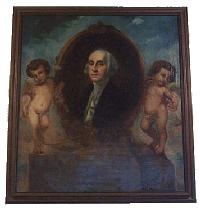
Picking up the Pieces
The Jasper family has been restoring antiques for 128 years, and the company repaired about 400,000 items last year, according to manager Jim Tipton. Owner David Jasper, representing the fourth generation of Jasper antique restorers, recently repaired a 4,000 year old bowl from Iraq. Now in the Smithsonian Institution, the bowl had been broken into 18 pieces, company literature reports.
The procedure to repair most items is pretty straightforward. First, Mirzaynts cleans off any old glue, and then he prepares and glues together broken pieces. "Use only a little glue - you don't hurry," Mirzaynts says. Sometimes he drills holes in the pieces and inserts pins for support, "like rebar in concrete," he says. He then fills in gaps using an epoxy resin, and actually reproduces some broken or missing pieces, such as a hand from a figurine. He wet-sands the item and refills where necessary. His tools are often diamond-tipped, for clean cutting and efficiency. He then paints the item, carefully matching the colors, and glazes the work to finish it off. The finish part of his work is similar to automobile body work, another job he once held here.
Often a customer will try to repair an item first, then give up and send it to Jasper. This gets Mirzaynts to shouting in Russian. He will even translate for you: "I don't like stupid customers!" he says. "They try to glue at home - where they get glue, I don't know, but it is for %$&@! - and every piece I need clean up!" Don't be offended, as he is an artist, and a craftsman, and an engineer, and these types can be very fussy - just be glad you didn't send him a broken bridge.
Though they do a majority of their work on Hummel figurines, the Jasper family can repair most any artifact. If it can't be restored to its original function, they can do something creative with it, such as making a bell out of broken stemware. Jasper doesn't guarantee "invisible" restoration, especially with clear glass, and they insist that their work is for ornamental use only. Don't have that figurine repaired as an investment, because it may take longer (and cost more) to repair it than it did to create it. "The majority of work that we do probably has more sentimental value than monetary," says Tipton.
It has been a long decade for Robert Mirzaynts; surviving tumultuous times in an unstable country, moving himself and his family to a land where he could not speak the language, and starting all over again. He has spent a decade picking up pieces of his life and gluing them back together.
Visit the Jasper web site: www.djglass.com
Like this story? Check out the
Return to our
|

 Mirzaynts was born and raised in the Soviet Union. In 1989, after a career as a mechanical engineer and electrician, he took a step toward a lifelong dream and applied to live in the United States. He spoke very little English at the time, and he still keeps a Russian/english dictionary on his workbench. He explains how he got to South Dakota; "When the embassy ask; 'where do you like to live?' I tell embassy; 'I do not know America. I go where you send me - I need safety for my two sons.'" He ended up in Sioux Falls, and even with the language handicap, he quickly found work - once in a pizza restaurant.
Mirzaynts was born and raised in the Soviet Union. In 1989, after a career as a mechanical engineer and electrician, he took a step toward a lifelong dream and applied to live in the United States. He spoke very little English at the time, and he still keeps a Russian/english dictionary on his workbench. He explains how he got to South Dakota; "When the embassy ask; 'where do you like to live?' I tell embassy; 'I do not know America. I go where you send me - I need safety for my two sons.'" He ended up in Sioux Falls, and even with the language handicap, he quickly found work - once in a pizza restaurant.
 Jasper repairs; crystal, porcelain, pottery, china, frames, figurines, vases, metal plating, bisque, lamps, dolls and oil paintings. Taste in the artwork is not an issue.
Jasper repairs; crystal, porcelain, pottery, china, frames, figurines, vases, metal plating, bisque, lamps, dolls and oil paintings. Taste in the artwork is not an issue.
 Mirzaynts makes a flower out of epoxy resin for a broken bowl.
Mirzaynts makes a flower out of epoxy resin for a broken bowl.
 Items are painted using colors selected from a large collection of paints.
Items are painted using colors selected from a large collection of paints.
